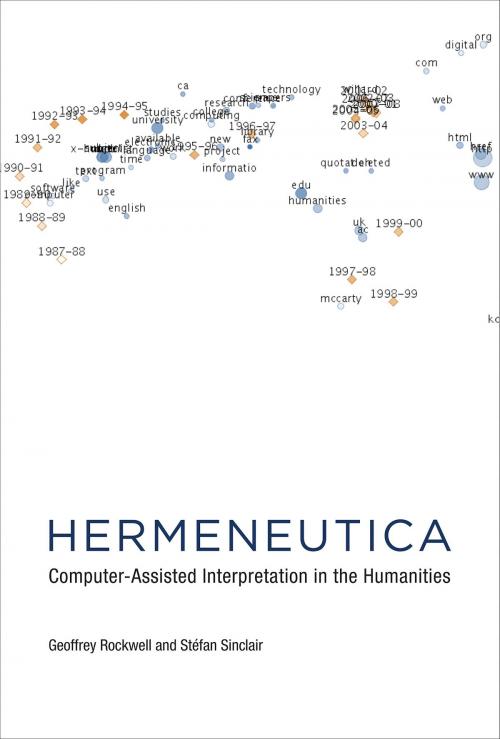Hermeneutica
Computer-Assisted Interpretation in the Humanities
Nonfiction, Computers, Application Software, Educational Software, Reference & Language, Education & Teaching| Author: | Geoffrey Rockwell, Stéfan Sinclair | ISBN: | 9780262332071 |
| Publisher: | The MIT Press | Publication: | April 1, 2016 |
| Imprint: | The MIT Press | Language: | English |
| Author: | Geoffrey Rockwell, Stéfan Sinclair |
| ISBN: | 9780262332071 |
| Publisher: | The MIT Press |
| Publication: | April 1, 2016 |
| Imprint: | The MIT Press |
| Language: | English |
An introduction to text analysis using computer-assisted interpretive practices, accompanied by example essays that illustrate the use of these computational tools.
The image of the scholar as a solitary thinker dates back at least to Descartes' Discourse on Method. But scholarly practices in the humanities are changing as older forms of communal inquiry are combined with modern research methods enabled by the Internet, accessible computing, data availability, and new media. Hermeneutica introduces text analysis using computer-assisted interpretive practices. It offers theoretical chapters about text analysis, presents a set of analytical tools (called Voyant) that instantiate the theory, and provides example essays that illustrate the use of these tools. Voyant allows users to integrate interpretation into texts by creating hermeneutica—small embeddable “toys” that can be woven into essays published online or into such online writing environments as blogs or wikis. The book's companion website, Hermeneuti.ca, offers the example essays with both text and embedded interactive panels. The panels show results and allow readers to experiment with the toys themselves.
The use of these analytical tools results in a hybrid essay: an interpretive work embedded with hermeneutical toys that can be explored for technique. The hermeneutica draw on and develop such common interactive analytics as word clouds and complex data journalism interactives. Embedded in scholarly texts, they create a more engaging argument. Moving between tool and text becomes another thread in a dynamic dialogue.
An introduction to text analysis using computer-assisted interpretive practices, accompanied by example essays that illustrate the use of these computational tools.
The image of the scholar as a solitary thinker dates back at least to Descartes' Discourse on Method. But scholarly practices in the humanities are changing as older forms of communal inquiry are combined with modern research methods enabled by the Internet, accessible computing, data availability, and new media. Hermeneutica introduces text analysis using computer-assisted interpretive practices. It offers theoretical chapters about text analysis, presents a set of analytical tools (called Voyant) that instantiate the theory, and provides example essays that illustrate the use of these tools. Voyant allows users to integrate interpretation into texts by creating hermeneutica—small embeddable “toys” that can be woven into essays published online or into such online writing environments as blogs or wikis. The book's companion website, Hermeneuti.ca, offers the example essays with both text and embedded interactive panels. The panels show results and allow readers to experiment with the toys themselves.
The use of these analytical tools results in a hybrid essay: an interpretive work embedded with hermeneutical toys that can be explored for technique. The hermeneutica draw on and develop such common interactive analytics as word clouds and complex data journalism interactives. Embedded in scholarly texts, they create a more engaging argument. Moving between tool and text becomes another thread in a dynamic dialogue.















